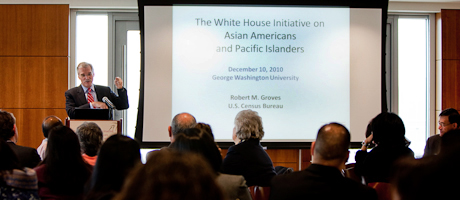The George Washington University hosted the first ever data conference Friday to evaluate the access of Asian American, Native Hawaiian and Pacific Islanders to federal programs and services.
More than 100 people gathered in GW’s City View Room in 1957 E Street to discuss ways to increase the gathering, analysis and use of data to improve the quality of life for Asian Americans and Pacific Islanders.
“I see this as a very historic gathering. It really is about working toward fostering the collection and research and analysis of our communities and disaggregating data. Because if we don’t have data, we’re helpless. We’re almost held hostage. We can’t advocate for our communities or ask for resources,” said Kiran Ahuja, executive director of the White House Initiative on Asian Americans and Pacific Islanders.
Last October, President Barack Obama signed an executive order reestablishing the White House Initiative on Asian Americans and Pacific Islanders. The initiative, which is housed within the U.S. Department of Education and the U.S. Department of Commerce, works to improve the quality of life and opportunities for Asian Americans and Pacific Islanders by facilitating increased access to and participation in federal programs where they remain underserved.
“GW’s Graduate School of Education and Human Development is honored to host this event, which will promote discussions and cultivate collaborations between researchers and the federal government about how to expand access to high quality education and other advancement opportunities for Asian American and Pacific Islander youth,” says Michael J. Feuer, GSEHD dean.
Ms. Ahuja stressed the need to disaggregate Asian American, Native Hawaiian and Pacific Islander data into three distinct groups instead of grouping them in one large group because Native Hawaiians and Pacific Islanders are much smaller populations.
“Limited data means fewer resources in funding for serious health issues and limited access to culturally appropriate health care,” she said.
Robert M. Groves, director of the U.S. Census Bureau, said the population of Asian Americans is growing rapidly in the U.S.
From 2000 to 2009, the Asian American population increased by 32 percent, compared with a 9 percent growth for the overall U.S. population, according to Census data. The three areas in the U.S. with the largest Asian American population growth over the past nine years are Loudoun County, Va., Brazoria, Texas and Pasco, Fla.
“Here at GSEHD, we share a common interest in focusing on closing the achievement gap to access to high quality education, to jobs and to affordable housing that all Asian Americans, Native Hawaiians and Pacific Islander constituencies face at a disproportionate rate,” said Joel Gomez, GSEHD associate dean for research and associate professor for educational leadership. “We also have a shared interest in helping initiate and build policies that would bring about social change and social justice for all communities.”


